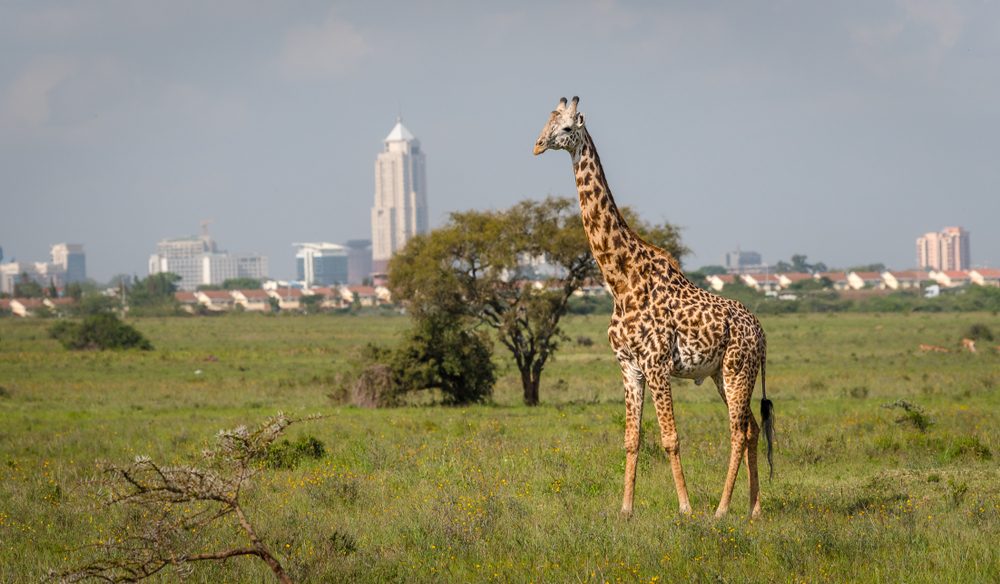Best Self Drive Guide Nairobi National Park
Nairobi National Park, known as “the world’s only wildlife capital,” is an exceptional wildlife attraction in Kenya, located in Nairobi, the capital city. It is a short drive from the central business district and features a stunning background of the city’s skyscrapers.
The park encompasses 117 square kilometers, with three sides (northern, eastern, and western) secured by electric fencing, while the southern boundary remains open, serving as a migratory route for animals traveling between the park and the adjacent Kitengela plains. Nairobi National Park is characterized by expansive grasslands and dispersed acacia shrubs, intersected by the Mbagathi River, which delineates the southern boundary; it is the sole protected area within the Athi-Kapiti ecosystem.
The historical background of Nairobi National Park
Nairobi, where Nairobi National Park is located, was formerly referred to as the Athi Plains to the east and south, which served as grazing grounds for the nomadic Maasai and their herds amidst the animals. The Kikuyu people resided and cultivated in the forested hills; as Nairobi expanded by 1910, its burgeoning population led to conflicts between humans and wildlife. The city’s inhabitants were required to carry firearms at night to safeguard themselves from lions and other wildlife.
Upon Mervyn Cowie’s return, a conservationist born in Kenya after a nine-year hiatus, he was dismayed by the decline in wildlife in the Athi plains, attributed to the expansion of agriculture and the proliferation of livestock. Mervyn Cowie reflected on the utopia this region once was, which was rapidly vanishing; at that time, the area was incorporated into the Southern Game Reserve, where hunting was prohibited. In addition to hunting, activities such as livestock grazing, trash disposal, and bombing by the Royal Air Force were permitted.
Mervyn Cowie initiated a campaign for the creation of a national park system in Kenya, prompting the British government, then the ruling authority, to organize a committee to investigate the issue. Nairobi National Park was founded in 1946, becoming the inaugural national park in Kenya, with Mervyn Cowie appointed as director, a role he maintained until 1966.

Fauna in Nairobi National Park
The park serves as a habitat for a diverse array of wildlife and avian species, including lions, leopards, African buffalo, black rhinoceroses, giraffes, hippopotamuses, spotted hyenas, blue wildebeests, plains zebras, Grant’s gazelles, common elands, common warthogs, hartebeests, olive baboons, black-backed jackals, Nile crocodiles, and impalas, among others.
Avifauna in Nairobi National Park
The park is a prominent avian destination in Kenya, boasting a total of 500 recorded bird species, including the Abyssinian thrush, Corncrake, Fischer’s lovebird, Grey crowned crane, Hartlaub’s bustard, Jackson’s widowbird, Kori bustard, Lappet-faced vulture, Lesser kestrel, Martial eagle, Pallid harrier, Secretary bird, Sharpe’s longclaw, Sooty falcon, White-bellied bustard, and White-headed vulture, among others. The avifauna in Nairobi National Park comprises both permanent and migratory species.
Activities to undertake during a safari in Nairobi National Park, Kenya
Safari excursions
Game drives constitute a prominent feature of tours in Kenya’s parks, available in both morning and evening sessions. Morning game drives are particularly advantageous for observing a diverse array of wildlife, including rhinos, giraffes, blue wildebeests, plains zebras, Grant’s gazelles, common elands, common warthogs, hartebeests, olive baboons, black-backed jackals, Nile crocodiles, impalas, and numerous others in substantial quantities. The evening game drive is ideal for observing these creatures as they emerge from their concealment around dusk.

Pedestrian safaris
The park serves as an ideal location for walking safaris in Kenya, featuring a stunning backdrop of city skyscrapers that enhances the experience of this remarkable pastime. Walking safaris occur on many trails throughout the park, allowing participants to observe various creatures, including giraffes, hippos, elands, and numerous bird species like as the white-bellied bustard, white-headed vulture, and secretary bird, among others.
Bird Watching
Nairobi National Park is recognized as one of the premier sites for birding safaris in Kenya, owing to its substantial population of avian species, which exceeds 500. Birdwatching in the park is an exhilarating pursuit for avian enthusiasts, conducted under the supervision of a birding guide. During this tour in Kenya, participants may observe species such as the Grey Crowned Crane, Hartlaub’s Bustard, Jackson’s Widowbird, Kori Bustard, Lappet-faced Vulture, Lesser Kestrel, Martial Eagle, Pallid Harrier, Secretary Bird, Sharpe’s Longclaw, Sooty Falcon, White-bellied Bustard, White-headed Vulture, among others.
Accommodation within Nairobi National Park
Nairobi National Park offers a diverse selection of safari lodges, hotels, and camps, classified into luxury, midrange, and economy accommodations. These lodging establishments comprise
Opulent lodging includes Ololo Safari Lodge, Nairobi Tented Camp, Ole Safari Hotel, and African Heritage House.
Midrange accommodations include Bush House and Camp, Anga Afrika Luxury Boutique Camp Nairobi, Tawala Homes, and Stardom Hotel.
Economical lodging options include Royal Tulip Canaan Nairobi, Town Lodge Uphill, Fairview Hotel, After 40 Hotel, Lotos Inns and Suites Nairobi, DoubleTree by Hilton Nairobi, and Radisson Blu Hotel Nairobi, among others.
Directions to Nairobi National Park
Nairobi National Park is located in Nairobi, the capital city, approximately 7 kilometers south of the city center, and may be entered through various entry points, including Maasai Gate, Mbagathi Gate, Banda Gate, Lang’ata Gate, and the KWS headquarters. Accessing Nairobi National Park can be achieved using both terrestrial and aerial transportation methods.
By road, it is around 7 kilometers south of the city center and about 10 kilometers from Jomo Kenyatta International Airport.
Air Transport, International tourists arrive by plane at Jomo Kenyatta International Airport, while those on a combined safari may utilize local charter flights to Wilson Airport, followed by a drive to the park.
